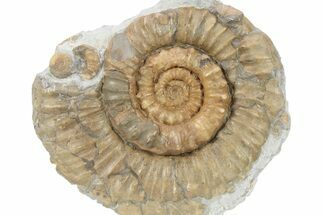This Specimen has been sold.
Three Iridescent Ammonites (Psiloceras) - England
This plate contains three brilliantly iridescent ammonites (Psiloceras planorbis, largest 1.95" wide) from England. Their naturally iridescent shells display some beautiful blues, greens, and fiery oranges. Like most fossils from the Blue Lias Formation, these ammonites have been compressed and flattened by the same geological processes of heating and pressure, forming this iridescence. This beautiful piece comes with an acrylic display stand.
About Ammonites
Ammonites were ancient marine cephalopods, similar to today's squids and octopuses, but with a defining feature: their distinctive, tightly coiled spiral shells. These shells, resembling those of modern nautiluses, served as both a protective home and a buoyancy aid, allowing ammonites to navigate the prehistoric seas with ease. First emerging around 240 million years ago in the Triassic Period, ammonites thrived for over 175 million years, adapting through numerous forms and sizes. As predatory creatures, they likely fed on smaller marine organisms, using their tentacles to capture prey. However, their long reign came to an end 65 million years ago at the close of the Cretaceous, coinciding with the mass extinction event that also eliminated the dinosaurs.
Ammonites were ancient marine cephalopods, similar to today's squids and octopuses, but with a defining feature: their distinctive, tightly coiled spiral shells. These shells, resembling those of modern nautiluses, served as both a protective home and a buoyancy aid, allowing ammonites to navigate the prehistoric seas with ease. First emerging around 240 million years ago in the Triassic Period, ammonites thrived for over 175 million years, adapting through numerous forms and sizes. As predatory creatures, they likely fed on smaller marine organisms, using their tentacles to capture prey. However, their long reign came to an end 65 million years ago at the close of the Cretaceous, coinciding with the mass extinction event that also eliminated the dinosaurs.
SPECIES
Psiloceras planorbis
LOCATION
Noth Somerset, England
FORMATION
Blue Lias Formation
SIZE
Largest: 1.95" wide, Rock: 8.45 x 7.2"
CATEGORY
SUB CATEGORY
ITEM
#280330
We guarantee the authenticity of all of our specimens.
 Reviews
Reviews












